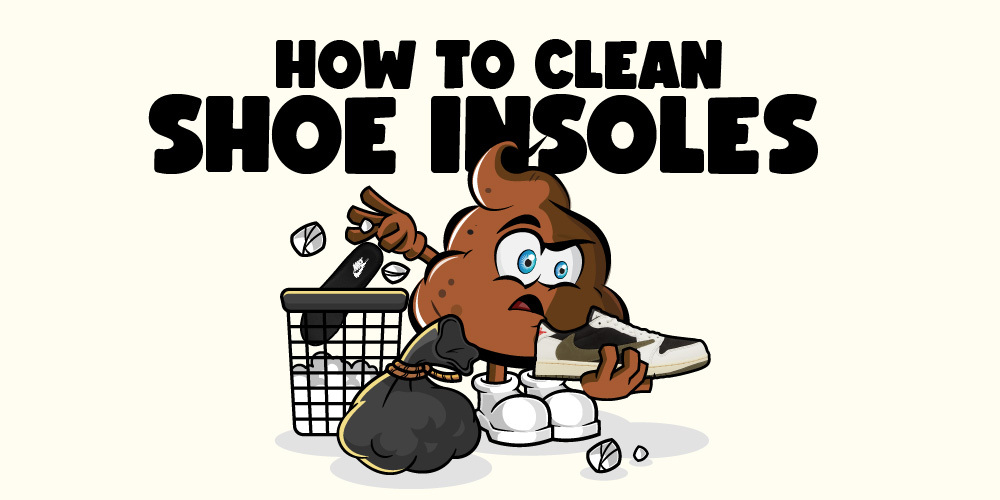Foul Odors, Fresh Solutions! Here’s How To Clean Shoe Insoles!
Keeping our kicks fresh for the long haul is just as vital as knowing how to cop them like a pro! Yet, it takes more than wishful thinking. Basically, you’ll probably need a kick-ass cleaning kit like SneakerAid, which can keep your elbow work at a minimum. But while we often pay attention to the flashy upper parts during cleaning, let’s not overlook those insoles! Because, truth be told, even the best of us end up with less-than-fresh insoles. But fear not, here’s how to clean shoe insoles and keep ’em feeling brand new! Now, before we dive in, don’t forget to check out our other sneaker-cleaning guides below.
- How to Clean White Sneakers
- How to Clean Leather Sneakers
- How to Clean Suede Sneakers
- How to Clean Shoe Laces

First, Why You Gotta Know How To Clean Shoe Insoles?
Just like your favorite pair of kicks, insoles deserve some love too! Ever wondered why insole care is so crucial?
Well, first off, by cleaning shoe insoles with regular TLC, you’re not just maintaining hygiene and foot health, you’re also ensuring lasting comfort and extending their lifespan. In other words, you’re saying goodbye to funky odors and pesky foot infections! In fact, with some proper cleaning and care, you can keep those insoles feeling as fresh as the day you unboxed them. So, if you’re all about happy feet, let’s dive into these tips and tricks to keep your shoe insoles clean, fresh, and oh-so-comfy!
How To Clean Shoe Insoles & Keep Them Tip-Top Condition
How To Clean Removable Shoe Insoles
#1 Beyond Baking: The Magic of Baking Soda
Basically, baking soda is known for trapping and absorbing tough odors, making cleaning easier. So, here’s how to use it to clean shoe insoles:
Fill a large container with baking soda:
- Shake a few ounces of baking soda into a Tupperware container or quart-sized Ziploc bag.
- Ensure the chosen container has a secure lid or closure to seal in the baking soda.
Place the insoles inside the container:
- Submerge the insoles in the baking soda, ensuring they’re fully covered.
- Position them upside down for better contact with the powder.
- Ensure the insoles are mostly dry before applying the baking soda.
- If no container is available, sprinkle the baking soda directly onto the insoles
Let the insoles sit overnight:
- Seal the container tightly and store it in a hidden spot.
- Let the baking soda work its magic overnight to lock in the strongest odors.
- Allow the baking soda to work for 6–8 hours for optimal results.
Lastly, remove and replace the insoles:
- Open the container and discard the used baking soda.
- Shake off any remaining powder from the insoles.
- Let the insoles air out for a few minutes before placing them back into your shoes.
And Voila! You should no longer detect any unpleasant odors lingering in your shoes.
#2 Scrubbing Insoles with Soap & Water: Give’ ‘em a Sudsy Spa Day!
Remove the insoles from your shoes.
- Lift the insoles out of the shoes and give them a breather to air out.
- Brush off any visible dirt or debris to prep them for a deep clean.
- For shoes without removable insoles, gently scrub inside the shoe by hand.
- If the shoes are machine washable, toss them in on a gentle cycle.
Next, combine soap and hot water in a large container.
- Fill up the sink or a bucket with warm water.
- Add a few drops of mild liquid dish detergent and mix to create a soapy solution.
- Warmer water is preferable for loosening tough dirt and stains.
- A gentle scrub with soap and water should suffice for lightly soiled insoles.
Then, dip a stiff-bristled brush in the soap solution.
- Scrub the insoles with a nylon dish brush or similar tool.
- Use a small amount of soapy water to prevent oversaturation.
- Avoid excessive moisture to prevent damage to the insoles.
- Opt for a soft dish sponge or cotton washcloth for gentle scrubbing.
Brush down the entire insole with the soapy water.
- Scrub the insoles with tight, circular motions, focusing on the heel and toes.
- Flip the insoles and scrub the bottoms.
- Reapply soap solution as needed.
- Clear away soap residue with a clean cloth or sponge.
Finally, allow the insoles to air dry.
- Allow the insoles to dry completely before wearing them again.
- Speed up the drying process by leaving the insoles in a well-ventilated area.
- Place the insoles out in the sun to dry if the weather is good. Great Job!
Now, How to Clean Non Removable Insoles?
Basically, cleaning non-removable insoles requires a different process. Rubbing alcohol is the secret sauce. Indeed, it kills bacteria and odors without the need for rinsing. Here’s how!
- Mix equal parts alcohol and water in a bowl or spray bottle.
- Dip a cloth in the liquid and wipe the insoles thoroughly, or spray it directly onto the insoles.
- Once cleaned, allow the insoles to air dry completely. And you’re done!
Signs That Insoles Need Replacing
You should know that shoe insoles give clear signals when it’s time for a change. So, here are the common signs to watch out for:
- Flattened Support: When the arch support loses its shape or appears damaged.
- Visible Wear: Cracks, tears, or holes in the insole are telltale signs.
- Persistent Odor: If the smell lingers despite cleaning efforts, it’s time for new insoles.
- Color Changes: Noticeable discoloration indicates material breakdown.
- General Rule: Replace insoles every 6-12 months, adjusting based on your activity level and usage.
Extra Hacks To Keep Your Shoe Inserts Fresh
Here are some extra tips & tricks to keep your insoles fresh. First, wear and change socks regularly to absorb sweat. Moreover, make sure to air out your insoles after each use to keep them dry. Also, opt for breathable materials and consider anti-odor options for long-lasting freshness. Lastly, remember to store your shoes in a dry place and remove wet insoles to dry separately. Following these simple steps, you will help maintain clean and odor-free insoles for longer!
For more stories, cleaning guides, or repair tips on sneakers, make sure to check out our ultimate blog. Catch you later, fam!
